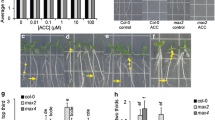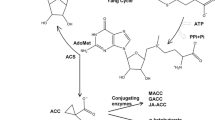Abstract
Ethylene was found to alter the shoot gravitropic response a century ago. However, its actual effects remained controversial over the century. In the present study, we investigated the effects of ethylene on the gravitropic response of Arabidopsis inflorescence and discovered that although the intact Arabidopsis inflorescence bent upward at the rate of 43∘ ±3∘/h in the first 1.5 h under the given control growth conditions, it bent upward at a rate of 20∘±3∘ and 64∘±14∘/h in the presence of exogenous ethylene if the plants were pretreated for 0.5 and 12 h, respectively, before the initiation of gravistimulation. The increase in gravicurvature rate is proportional to the length of ethylene pretreatment. The minimum ethylene pretreatment time required for achieving the maximum curvature rate is 10–11 h with removal of exogenous ethylene. The stimulatory effect of ethylene on the inflorescence gravicurvature requires a latent period of time (1 h) to become measurable. In contrast, the inhibitory effect of ethylene becomes measurable shortly after application of ethylene. The stimulatory effect remained nearly unchanged when the applied ethylene concentration increased from 0.1 to 10 μl/L. However, the inhibitory effect increased substantially as ethylene concentration increased to 10 μL/L. These results suggest that ethylene simultaneously exerts both stimulatory and inhibitory effects on the gravitropic response of the inflorescence, and the stimulatory effect dominates over the inhibitory effect during the interplay between the two in the inflorescence. A “Yin and Yang” action model is hereby proposed to address the interplay between the two effects of ethylene. They may act through distinct signaling pathways.
Similar content being viewed by others
References
Yang, S. F., Hoffman, N. E., Ethylene biosynthesis and its regulation in higher plants, Annu. Rev. Plant Physiol., 1984, 35: 155.
Abeles, F. B., Morgan, P. W., Saltveit, M. E., Ethylene in Plant Biology (2nd ed.), San Diego: Academic Press, 1992.
Kende, H., Ethylene biosynthesis, Annu. Rev. Plant Physiol. Plant Mol. Biol., 1993, 44: 283.
Fluhr, R., Mattoo, A. K., Ethylene biosynthesis and perception, Crit. Rev. Plant Sci., 1996, 15: 479.
Wright, M., Mousdale, D. M. A., Osborne, D. J., Evidence for a gravity-regulated level of endogenous auxin controlling cell elongation and ethylene production during geotropic bending in grass nodes (Echinochloa colonum), Biochem. Physiol. Pflanzen., 1978, 172: 581.
Kaufman, P., Pharis, R. P., Reid, D. M. et al., Investigations into the possible regulation of negative gravitropic curvature in intactAvena sativa plants and in isolated stem segments by ethylene and gibberellins, Physiol. Plant, 1985, 65: 237.
Harrison, M. A., Pickard, B. G., Evaluation of ethylene as a mediator of gravitropism by tomato hypocotyls, Plant Physiol., 1986, 80: 592.
Neljubow, D., Ueber die horizontale Nutation der strengel von Pism sativum und einiger anderer, Pflanzen. Beih. Bot. Zentralbl, 1901, 10: 128.
Harrison, M., Pickard, B. G., Burst of ethylene upon horizontal placement of tomato seedlings, Plant Physiol., 1984, 75: 1167.
Balatti, P. A., Willemoes, J. G., Role of ethylene in the geotropic response of bermudagrass (Cynodon dactylon L. Pers.) stolons., Plant Physiol., 1989, 91: 1251.
Wheeler, R. M., White, R. G., Salisbury, F. B., Gravitropism in higher plant shoots, IV. Further studies on participation of ethylene, Plant Physiol., 1986, 82: 534.
Wheeler, R. M., Salisbury, F. B., Gravitropism in plant stems may require ethyleneXanthium strumarium, Science, 1980, 209: 1126.
Wheeler, R. M., Salisbury, F. B., Gravitropism in higher plant shoots Cocklebur, tomatoes, castor bean, I. A role for ethylene, Plant Physiol., 1981, 67: 686.
Golan, A., Tepper, M., Soudry, E. et al., Cytokinin, acting through ethylene, restores gravitropism to arabidopsis seedlings grown under red light, Plant Physiol., 1996, 112: 901.
Madlung, A., Behringer, F. J., Lomax, T. L., Ethylene plays multiple nonprimary roles in modulating the gravitropic response in tomato, Plant Physiol., 1999, 120: 897.
Zobel, R. W., Control of morphogenesis in the ethylene-requiring tomato mutant, diageotropica, Can. J. Bot., 1974, 52: 735.
Lu, B. W., Chan, W. K., Zhang, H. et al., Ethylene as a Dual Function Modulator of the Negative Gravitropism of Arabidopsis Inflorescence Stem, Plant Biology ’99 July 24–28, Baltimore, MD, USA, 1999.
Fukaki, H., Fujisawa, H., Tasaka, M., Gravitropic response of inflorescence stems inArabidopsis thaliana, Plant Physiol., 1996, 110: 933.
O’Donnell, P. J., Calvert, C., Atzorn, R. et al., Ethylene as a signal mediating the wound response of tomato plants, Science, 1996, 274: 1914.
Finney, D. J., Statistical Method in Biological Assay (Griffin, London, ed. 3), 1978.
Wong, M. Y., The statistical analysis of slope ratio assays using SAS software, Comput. Meth. Prog. Biomed., 1994, 45: 233.
Burg, S. P., Kang, B. G., Cellular and molecular aspects of the plant hormone ethylene (ed. J. C. Pech), Dordrecht: Kluwer Academic Publisher, 1993, 335–340.
Ecker, J. R., The ethylene signal transduction pathway in plants, Science, 1995, 268: 667.
Clark, K. L., Larsen, P. B., Wang, X. et al., Association of theArabidopsis CTR1 raf-like kinase with the ETR1 and ERS ethylene receptors, Proc. Natl. Acad. Sci. USA, 1998, 95: 401
Utsuno, K., Shikanai, T., Yamada, Y. et al., AGR, an Agravitropic locus of Arabidopsis thaliana, encodes a novel membrane-protein family member, Plant & Cell Physiol., 1998, 39: 1111.
McQueen-Mason, S. J., Cosgrove, D. J., Expansin mode of action on cell walls, Plant Physiol., 1995, 107: 87.
Estelle, M., Plant tropisms: the ins and outs of auxin, Curr. Biol., 1996, 6: 1589.
Chen, R., Rosen, E., Masson, P. H., Gravitropism in higher plants, Plant Physiol., 1999, 120: 343.
Burg, S. P., Burg, E. A., The interaction between auxin and ethylene and its role in plant growth, Proc. Natl. Acad. Sci. USA, 1966, 55: 262.
Morgan, P. W., Gausman, H. W., Effects of ethylene on auxin transport, Plant Physiol., 1966, 41: 45.
Chang, S. C., Lee, M. S., Lee, S. M. et al., Ethylene-induced auxin sensitivity changes in petiole epinasty of tomato mutantdgt, J. Plant Biol., 1994, 37: 257.
Bleecker, A., Estelle, M., Somerville, C. et al., Insensitivity to ethylene conferred by a dominant mutation inArabidopsis thaliana, Science, 1988, 241: 1086.
Author information
Authors and Affiliations
Corresponding author
About this article
Cite this article
Lu, B., Pei, L.K., Chan, WK. et al. The dual effects of ethylene on the negative gravicurvature of arabidopsis inflorescence, an intriguing action model for the plant hormone ethylene. Chin.Sci.Bull. 46, 279–283 (2001). https://doi.org/10.1007/BF03187185
Received:
Issue Date:
DOI: https://doi.org/10.1007/BF03187185




